06 July 2018
By portermathewsblog
popsugar.com.au

Image Source: A House in the Hills
If there are rules that you as a renter must follow, make it these 10 commandments. Because, while paying your rent on time is important, so too is making sure your place is personalised and stylish. Working within the boundaries of your landlord, it’s little things like a new light fixture that will make an impact without costing a lot of time or money. And, the best part about this entire list is that you’ll leave with your security deposit intact once it’s time to move up and on.
- Thou Shalt Add Storage
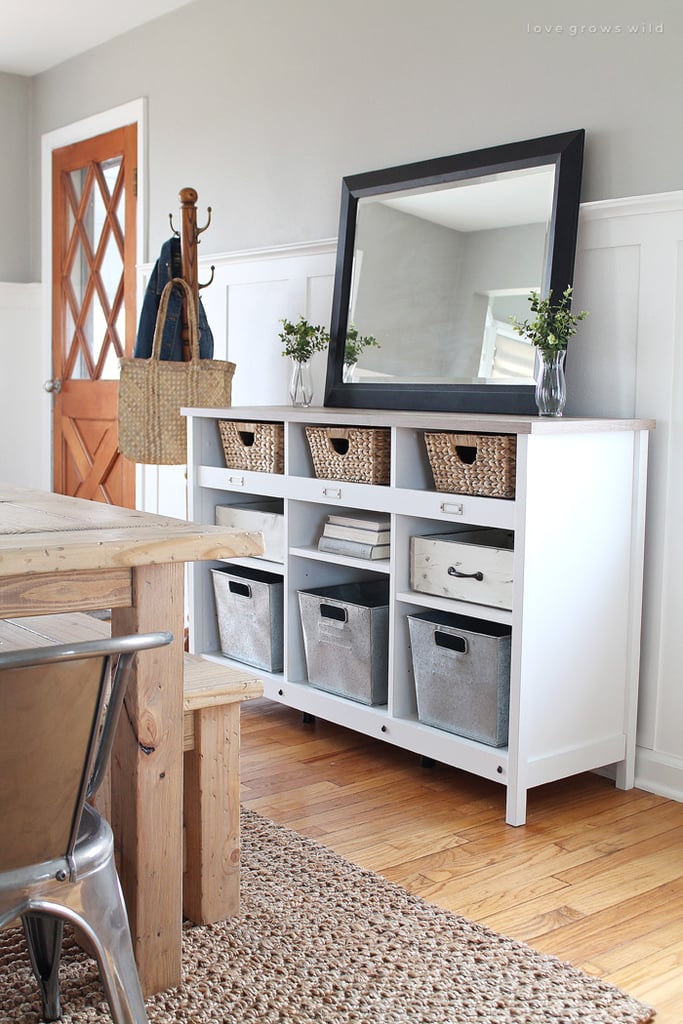
Let’s get real, custom cabinetry is not an option if you don’t own the place. Since rentals usually lack storage, add your own with affordable Ikea bookcases, simple shelves, or these organising solutions.
- Thou Shalt Change the Hardware
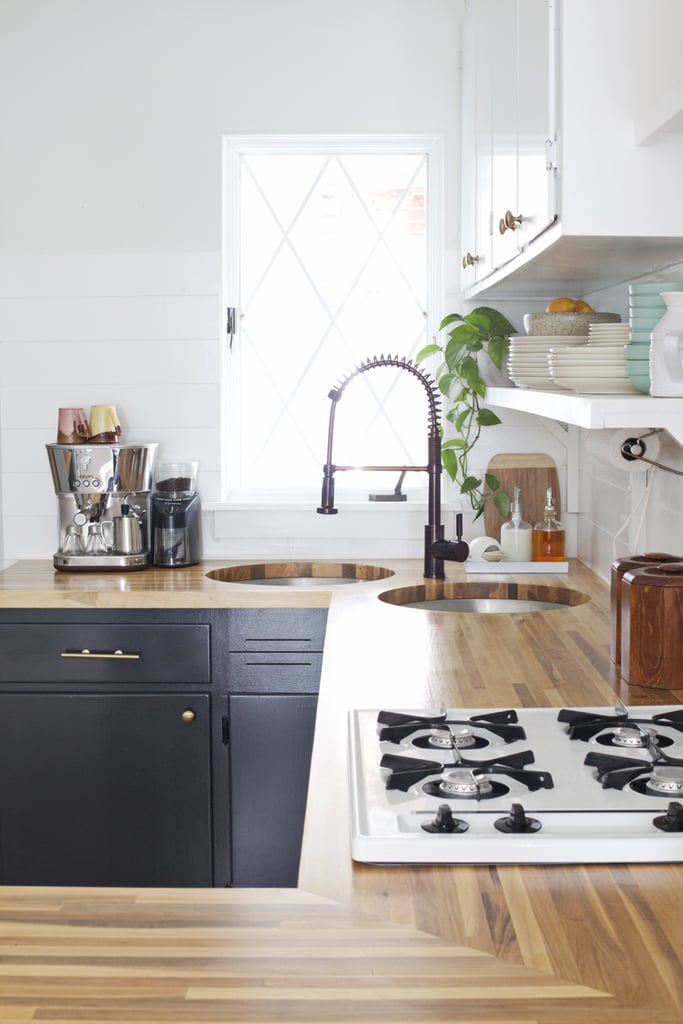
Rental hardware is basic . . . your style, not so much. Switching out cabinet pulls and bathroom hardware will make a huge difference. Just remember to keep the original pieces to swap back in before moving out.
- Thou Shalt Ditch Vertical Blinds

Image Source: Dana Miller for House*Tweaking
They are the ultimate decorating sin! To prevent your space from looking like a hospital room, take them down or hide them under curtains. Again, don’t toss — they’re essential if you want your security deposit back.
- Thou Shalt Line Cabinets
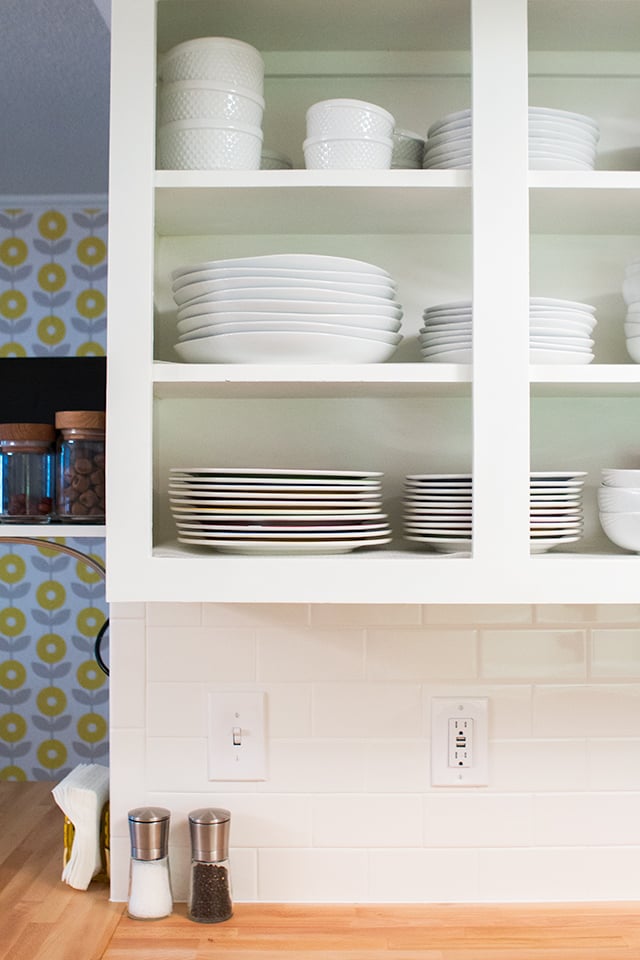
This might seem trivial and a bit annoying, but lining your cabinets is a must. Not only will it make your kitchen look clean, but also it will mask worn and grungy cabinets without having to paint. Adhesive liner works, but a softer grip liner is better because it’s easy to install; it will also prevent glassware from chipping.
- Thou Shalt Accessorise Like Crazy
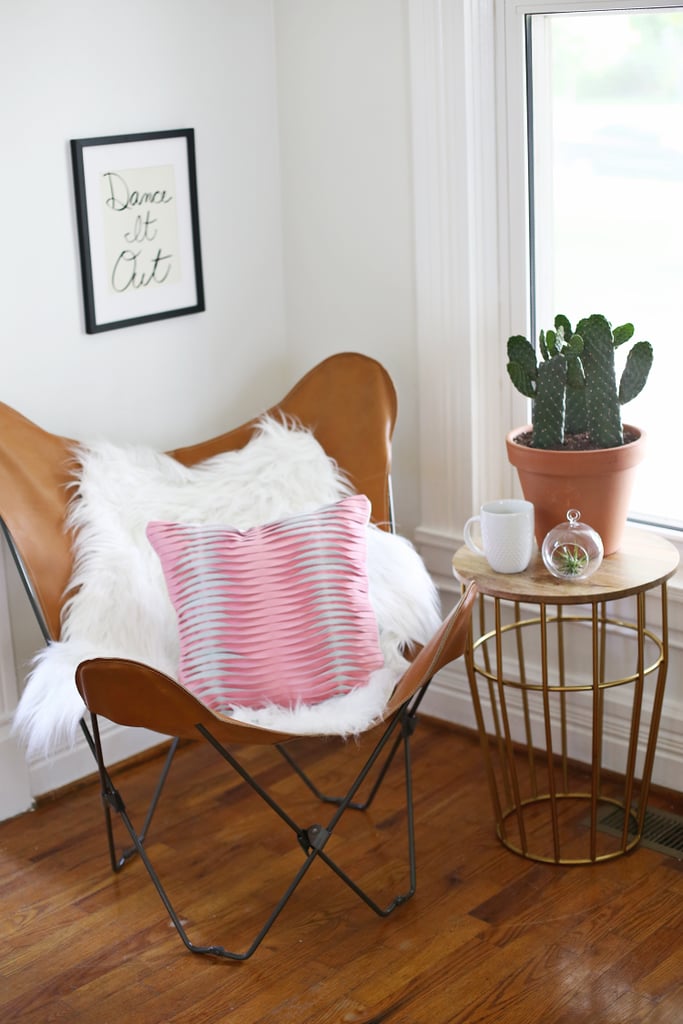
It’s true, and that’s the only way you’re going to get a truly personal space. Go to town with throws, pillows, and accents that reflect your style.
- Thou Shalt Avoid Wallpaper

Well, in most cases. Sure it’s stylish, but in all honestly, wallpaper is really inconvenient to remove, especially if you won’t be in your place for long. If you love the patterned look, consider the removable wallpaper seen in this studio or these alternative wallpaper ideas.
- Thou Shalt Hang Art
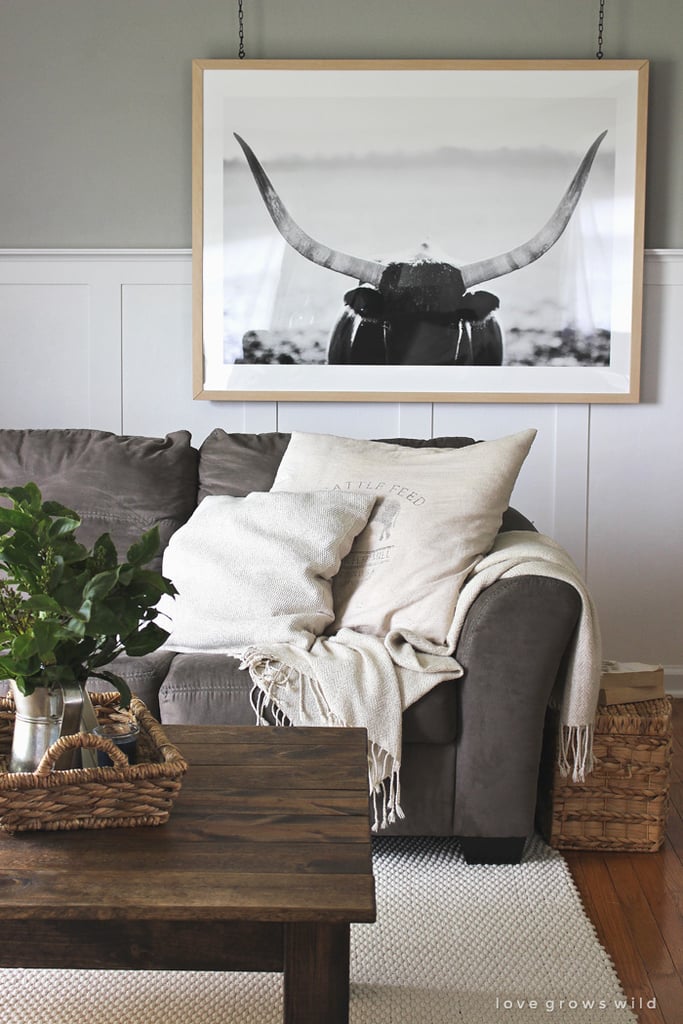
Image Source: Love Grows Wild
No excuses — get your art on the walls! Patching up a tiny hole come move-out day is nothing compared to the impact it will make on your space. No need to create a full-blown gallery wall either. Try hanging one statement piece and resting photos on a mantel or shelf, similar to this home.
- Thou Shalt Invest in Rugs

Especially if your place has carpet! Rugs are an easy way to cover up that not-so-cute carpet and can be packed up with you come your next move. Rugs are also a necessity to keep noise down, especially in older apartments with wood floors.
- Thou Shalt Emphasise Lighting
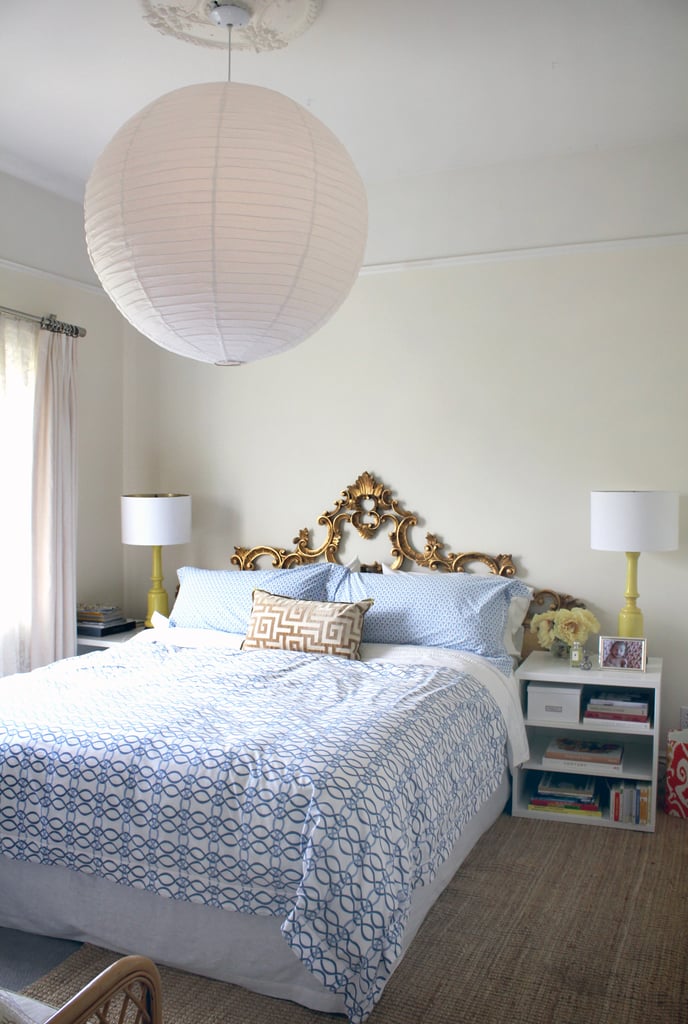
Image Source: POPSUGAR Photography
This is another trick that many renters often overlook. Take it from HGTV stars Anthony Carrino and John Colaneri who suggest you use lighting to set the tone and make an impact in a rental. Get creative with floor and table lamps that can easily be moved from place to place.
- Thou Shalt Make the Most of Plants

No yard? No problem. Pots are a great way to achieve the bohemian jungalow look or even have your own urban garden. The best part is you won’t have to fret about leaving any of them behind.
Comments (0)
14 May 2018
By portermathewsblog
via reiwa.com.au
 With steady rents, declining listings, improved leasing figures and faster leasing times, data for the March 2018 quarter reveals Perth’s rental market is leading the charge in Perth’s property market recovery.
With steady rents, declining listings, improved leasing figures and faster leasing times, data for the March 2018 quarter reveals Perth’s rental market is leading the charge in Perth’s property market recovery.
REIWA President Hayden Groves said the first quarter of 2018 showed Perth’s rental market had strengthened, with improvements recorded across all key indicators.
“Perth’s rental market appears to be building on the momentum of the latter half of 2017, which is very encouraging – not just for the rental market, but also for the overall property market. Historically, the sales market follows the rental market during a recovery,” Mr Groves said.
Median rent prices
Perth’s overall median rent price is $350 per week for the March 2018 quarter.
Mr Groves said this was the twelfth straight month of stable rent prices, with no changes recorded since April 2017.
“All sub-regions experienced stable median prices except for the South West sub-region, which saw its overall median rent price increase $10 to $330 per week during the quarter,” Mr Groves said.
reiwa.com data shows there was a $5 per week increase to both the median house and median unit rent during the March 2018 quarter.
“The median house rent increased to $360 per week, while the median unit rent increased to $325 per week,” Mr Groves said.
“It bodes well for landlords that the house and unit median rents are improving simultaneously.”
Leasing activity
There were 14,112 rental properties leased in Perth during the March 2018 quarter.
“Leasing volumes for the March 2018 quarter are up 4.2 per cent compared to the December 2017 quarter,” Mr Groves said.
“Four out of the five sub-regions saw an improvement in leasing volumes, with the Central sub-region (up 7.7 per cent) and North East sub-region (up 6.1 per cent) the stand-outs.”
At a suburb level, reiwa.com data shows East Cannington, St James, North Fremantle, Ellenbrook and Booragoon saw the biggest growth in leasing activity levels over the quarter.
Listings for rent
Rental listings declined 4.5 per cent during the quarter, with 8,508 listings recorded at the end of March 2018.
Mr Groves said there had been a substantial reduction in the number of rental properties available in Perth over the last 12 months.
“Compared to the March 2017 quarter, listings for rent are now 18.6 per cent lower than they were at the same time last year. This can be attributed to an increase in population growth to the state and fewer new dwelling commencements occurring in the metro area,” Mr Groves said.
Average leasing time
It was two days faster to lease a property during the March 2018 quarter than it was during the December 2017 quarter.
“It took 47 days on average for landlords to find a tenant during the March quarter, which is two days faster than the December quarter and three days faster than the March 2017 quarter,” Mr Groves said.
“With stock levels declining and leasing activity increasing, the Perth rental market is finally starting to re-balance. For tenants, now is a good time to secure a longer-term lease before rents rise.”
Comments (0)
23 April 2018
By portermathewsblog
via domain.com.au
In Australia’s perpetually crowded rental market, the odds of securing any sort of home – let alone one that ticks all your boxes – can seem daunting.
Fast-increasing prices and the advent of so-called “rental bidding” further complicate the picture. And during the summer months, fluctuations in stock can create wildly variable conditions from week to week.
But there is reason to be optimistic. Despite perceptions that the rental market is somehow rigged – particularly in large cities such as Sydney and Melbourne – agents and advocates say that ordinary Aussies stand a good chance of renting in 2018.
 Consider house-hunting in early January when there is less competition. Photo: Edwina Pickles
Consider house-hunting in early January when there is less competition. Photo: Edwina Pickles
If you understand what landlords are looking for, are willing to take care during the application process and choose the most appropriate month to search, you might be surprised by what you can secure.
1. Always write a cover letter
Few agents ask for one, but including a cover letter with your application can dramatically improve your chances of securing a rental.
Crucially, a one-page cover letter can find its way to the landlord, who is almost never present at inspections but has final say over who is granted the lease.Making a personal connection with the landlord through a cover letter can be very valuable.
 Make sure you have all your documentation ready before the inspection. Photo: Pat Scala
Make sure you have all your documentation ready before the inspection. Photo: Pat Scala
“Make it a good story,” says Eileen Carroll, sales director of Ray White Glebe. “Tell us why you’re the best person for the property. A little story about yourself will help your cause.”
2. Gather everything you’ll need – and then some
While some agents do not require additional documentation such as proof of ID and written references to be supplied at the time of application, Carroll says prospective tenants should submit these documents anyway.
“Have it all ready, so if you are accepted, you can actually secure the property,” she says. “If I’m chasing people for these documents before they’ve even signed the tenancy, alarm bells start to ring.”
 Agents may move on to the next applicant if you don’t have your deposit ready. Photo: Dan Soderstrom
Agents may move on to the next applicant if you don’t have your deposit ready. Photo: Dan Soderstrom
Providing ample references and other documents from the outset can also give you an advantage over less organised applicants.
“If someone submits an application with just a payslip from a month ago and a passport, it’s not really that interesting to me,” Carroll says. “But if the application has a covering letter, two current payslips, a personal or work reference and they’ve completed their 100 points of ID, I’m impressed.”
3. Apply online if you can
Scanning your hard-copy documents and completing an online application form may be irksome and time-consuming, but for agents it’s a godsend.
 Even if a property is popular, don’t be tempted to pay more than the advertised price. Photo: Eddie Jim
Even if a property is popular, don’t be tempted to pay more than the advertised price. Photo: Eddie Jim
“I had eight properties open two weeks ago and I leased all of them,” explains Carroll, “so the paperwork was miles long. Online applications make my life easier.”
Most online application forms also include a section for additional comments, so make sure you use it. “The standard form we use actually asks applicants to explain why they like the property in question, and I find that really helpful,” Carroll says. “It’s the first thing I go to now in the application because it gives me a better indication of who we’re dealing with.”
4. Think carefully before offering more than the listed price
Australia’s chronic shortage of inner-city housing has led to an increase in so-called “rental bidding”: offering more than the asking price in order to beat out the competition.
Leo Patterson Ross, advocacy and research officer at the Tenants Union of New South Wales, concedes that this strategy can be effective for those who can afford it. But he cautions that rental bidding can set a dangerous precedent.
“It’s pushing up prices not only for others but for yourself,” he says. By indicating a willingness to pay more than advertised, tenants may increase the likelihood of further rent rises in future, which could ultimately make the property unaffordable.
5. Be ready to pay your deposit
Having your application approved does not guarantee that the agent will hold the property for you. “If I call someone in the morning, tell them their application has been approved and ask for their deposit, and they say, ‘Oh, I’ll pay it later this afternoon’, I automatically go to the next application,” says Carroll.
“If they’re going to pay it later that afternoon, that tells me they’re waiting on the outcome of another application or they can’t afford my property.”
Carroll says delaying payment of your deposit by even a few hours can be risky. “I don’t want to lose my other applicants waiting for a deposit to be paid. Waiting a day for the deposit could mean my other applicants have moved on to other properties.”
6. Choose the most suitable month to apply
Unlike most of the year, when the number of properties on the Australian rental market is relatively stable, the months of January, February and March vary wildly in terms of volume.
According to Domain data, rental listings are at their lowest levels between late December and late January, when much of the country is on holiday. But some rental properties are open for inspection during this time.
Carroll says house-hunting in quiet early January can mean less competition and a better chance of striking up a relationship with a rental agent.
If you’d like to maximise your options, wait until late January or early February, when many landlords return from holidays. But remember that university students house-hunt during this time, increasing competition in less expensive suburbs.
If you can afford to wait until March, you’ll find the market returning to normal levels – and there may be an opportunity to pick up a bargain rental that didn’t lease during the February rush.
7. Don’t despair if you are young or haven’t rented before
Many prospective tenants assume that age and wealth trump all other considerations in the eyes of agents and landlords. But the truth is more nuanced.
“Real estate agents and landlords are ultimately trying to assess risk when choosing applicants,” says Patterson Ross. “The factors they are mainly considering are the ability to pay the rent, and the likelihood of damage occurring to the property.”
“A previous rental history is part of demonstrating that you represent a lower risk, but you can do this in other ways as well – most likely character references from employers or other people who can talk about things like your responsibility, cleanliness and so on.”
Carroll says she has rented properties to people without employment who could demonstrate significant savings, and to others who had less money than their competition. “For me, it’s ultimately about whether the application stands out or not,” she says.
Comments (0)
09 April 2018
By portermathewsblog
Author: REIWA President Hayden Groves via reiwa.com.au
 Although rent prices across the state have been on a downward trajectory for the last couple of years, the rate of decline has slowed with the median rent price holding steady at $350 per week since April last year.
Although rent prices across the state have been on a downward trajectory for the last couple of years, the rate of decline has slowed with the median rent price holding steady at $350 per week since April last year.
The number of rental properties on the market has also improved, declining to approximately 8,500 listings metro wide, well down from the peak of 11,300 in 2016.
While Perth landlords don’t enjoy the dominance they experienced a few years ago, property investment is still a smart decision. And thankfully, interest rates on borrowings continue to sit at historically low levels, mitigating some of the short term financial discomfort resulting from lower rent prices.
Get your asking price right from the start
When pricing your property and preparing it for lease, it’s crucial you heed the advice of your REIWA property manager. Tenants are out there in good numbers, in fact, leasing activity reached an all-time high last year and remains at above-average levels in 2018.
Provided your rental property is marketed competitively, you have a very good chance of securing a tenant. However, if you choose to price your property higher than your agent’s recommendations, tenants are very likely to bypass your listing.
The first two weeks of listing your property for rent are the most crucial. Get your initial asking price wrong and you can end up chasing down the market, destined to end up with a weekly rent price below market value, plus you’ll bear the rent cost you missed out on when your property was vacant.
Forecast looks positive for landlords
Pleasingly for landlords, the Perth rental market has improved over the last six months and we are slowly seeing it transition into a more balanced market.
The Perth vacancy rate declined to 5.3 per cent in January – the lowest level since July 2015 and down from a peak of 7.2 per cent in June 2017. This sharp decline indicates that normalcy is returning and market parity, in terms of supply and demand, is not far away.
Despite these obvious improvements, REIWA’s forecast for 2018 cautions against expectations of rapid growth in rent prices over the coming year. Property owners are still advised to meet the market – you are better off with less rent per week than having a long vacancy period with no rental income at all.
It is also advisable to be flexible with the conditions you put on your rental. For example, not allowing tenants who own a pet to rent your property can deter people who would otherwise be interested. It’s in your best interest to consider tenants with pets on a case-by-case basis, secure in the knowledge the bond, pet bond and landlord insurance will be there to cover any pet-related damage.
For obligation free landlord assistance Sarah Morgan 9475 9622
Comments (0)
12 March 2018
By portermathewsblog
via reiw.com.au
 Perth’s vacancy rate has dropped to 5.3 per cent – the lowest since July 2015.
Perth’s vacancy rate has dropped to 5.3 per cent – the lowest since July 2015.
REIWA President Hayden Groves said Perth’s latest vacancy rate for January 2018 had improved significantly since June 2017.
“It’s quite remarkable to see it this low considering seven months earlier Perth’s vacancy rate soared to 7.3 per cent – the highest we have ever experienced, and now it’s back at levels last seen in 2015.
“The vacancy rate is a good indicator for how the entire rental market is tracking, with reiwa.com data for February showing stable rent prices and declining listing levels. Leasing activity did drop off in February, however levels are still healthy and trending above long term averages,” Mr Groves said.
The reiwa.com vacancy rate is compiled using data obtained from a monthly survey of REIWA members. The survey details how many rental properties members manage and how many of those are vacant.
Mr Groves said there were a number of factors that had contributed to lowering the vacancy rate, such as an increase in population growth and a reduction in average tenure time.
“Population growth in WA has started to improve. Rental markets always feel the effects of population trends, with new entrants into the state the first to soak up rental stock.
“Tenants are also moving more frequently. In 2014 for example, the average tenure time was 45 months, fast forward to 2017 and it’s now 34 months, which is almost a full year less. This has led to an increase in leasing activity which has driven demand for rentals and had a positive effect on the vacancy rate.
“Another contributing factor is the reduction in the number of new dwelling commencements across the Perth Metro area. This has played an important role in lowering the vacancy rate. With less new dwellings coming onto the market, existing rental stock is now being soaked up, which is why rental listings have declined 19 per cent over the last year.
“After a challenging few years for landlords and investors, it’s pleasing to see some parity return to the rental market, with tenants and landlords seeing benefits simultaneously,” Mr Groves said.
Comments (0)
27 November 2017
By portermathewsblog
NICOLA MCDOUGALL via domain.com.au
During property transactions, sometimes the seller hasn’t found anywhere else to live by the time they sign on the dotted line.
One of the most common solutions to this situation is renting back the property to them for a period of time, but is it a good idea?
Property Pursuit director and buyers’ agent Meighan Hetherington said the “rent-back” option was more likely in an off-market sale that happened sooner than the seller had anticipated.
Deciding whether to offer a long settlement or a rent-back depends on each party’s circumstances. Photo: Gabriele Charotte
Renting back the property to the seller also gave the buyer a stronger negotiating position, she said.
“That’s a really strong position to be in from a negotiation point of view because we can meet the seller’s needs without offering more money,” she said.
“The seller can either have a long settlement with the comfort that they have got the sale or they can have a normal 30-day settlement and they can be cash buyer to jump on any opportunity if something comes up but not have to move before they’re ready.”
 It’s important for the tenancy agreement to be explained in detail to the seller to prevent any potential issues. Photo: Lisa Maree Williams
It’s important for the tenancy agreement to be explained in detail to the seller to prevent any potential issues. Photo: Lisa Maree Williams
Deciding whether to offer a long settlement or a rent-back depended on each party’s circumstances, but one usually put the buyer in a stronger position than the other, she said.
“You can often negotiate a better price by offering a normal settlement with a rent-back than you can in offering a long settlement,” Ms Hetherington said.
Long-standing Toowong sales agent and principal Doug Disher said rent backs were often mutually beneficial to both the seller and the buyer, such as when the property had been bought for future re-development purposes but the original owner had not found a replacement home.
But he said it was imperative that a formal lease was drawn up if renting back the property to the seller, to ensure the terms and conditions were clear.
“The most important thing in any arrangement is to ensure the terms are legal, clear and precise,” he said.
“It’s essential that both parties understand their obligations under any such arrangement. It is always best to get legal advice before entering into any agreement involving rent-back situations.”
Ms Hetherington said one of the risks with renting back a property was that many sellers had not rented for a long time and often misunderstand their rights and responsibilities as well as those of the landlord and property manager.
It was important for the tenancy agreement to be explained in detail to the seller to prevent any potential issues during the tenancy, she said. Likewise, an entry condition report was imperative.
“The entry condition report is the only piece of evidence that the new owner has to say what state that property should be left in by the tenant when they vacate,” she said.
Comments (0)
10 October 2017
By portermathewsblog
Samantha Jones via reiwa.com.au
 It’s no secret that the Perth rental market currently favours tenants, so if you’re looking to purchase an investment property it’s important to select a rental that appeals to your target market.
It’s no secret that the Perth rental market currently favours tenants, so if you’re looking to purchase an investment property it’s important to select a rental that appeals to your target market.
Unlike purchasing your own home to live in, buying an investment property needs to be approached with your head – not your heart. Features you may value in your own home, may not necessarily appeal to prospective tenants.
You need to think like a tenant and buy a property that meets their needs. Here are five tips for purchasing a rental that appeals to tenants:
1. Location is paramount
As with any property purchase, location is paramount. This is especially the case when buying an investment property.
A common tenant requirement is proximity to amenities. Be sure to buy in areas that are close to key amenities like shops, transport and schools. It’s also a smart idea to seek locations that offer a good lifestyle, for example younger tenants generally value living close to thriving hubs, while families with young children will value being close to parks and kid friendly facilities.
2. Consider the home’s internal layout
Give consideration to the internal layout of the property you choose to invest in. Many tenants choose to share accommodation, so it’s a good idea to look at properties that have features that appeal to this style of living.
Things to consider when assessing the home include:
- Is there good separation between living areas and bedrooms?
- How many bedrooms does the home have? Are they spacious?
- Is there more than one bathroom?
- Are there plenty of storage options?
3. Outdoor areas are important
We’re lucky in Western Australia that our climate is warm and favours outdoor living. With this in mind, it’s a good idea to factor in some kind of outdoor area into the rental home you purchase. Whether it’s a balcony, a courtyard or an enclosed alfresco – outdoor living options are attractive.
While many tenants value outdoor living space, it’s worthwhile choosing a home that is low maintenance. Gardens may look beautiful, but they require a lot of upkeep so it’s best to invest in properties with low maintenance outdoor areas as prospective tenants may be put off by the work required to keep a garden looking good.
4. Parking options are highly regarded
Being able to offer tenants a designated parking space is very attractive. While in WA most homes come equipped with a garage or carport, units or apartments – particularly those in the city – often require tenants to park off-street. A lack of parking options is an inconvenience to tenants, so it’s beneficial to look for investment properties that provide tenants with a secure space to park their car.
5. Extra features will help your rental stand out
As an investor, you need to be competitive in the current market to secure a tenant. In order to make your home stand out, it’s worth ensuring the property has some attractive extras like:
-
- Airconditioning – WA’s long hot summers can be uncomfortable without airconditioning. Tenants want to be able to escape the heat when inside, so airconditioning is often a key requirement.
- Quality appliances – modern appliances like ovens, dishwashers and cooktops can go a long way in helping your home stand out.
-
- Digital connections – we live in a technological age, so features like good cable connections for internet and wifi and strong mobile signals are increasingly important factors for tenants.
- Pet friendly – rental properties that accommodate pets will appeal to a wider selection of applicants.
If you have any questions about renting out your property in Perth, speak to Ron Padua on 0404 428 843 or email bdm@pmmetro.com.au
Comments (0)
12 September 2017
By portermathewsblog
Rachel Preston-Bidwell via reiwa.com.au
 Do you currently own an investment property in Perth or are looking to purchase one? We have four tips for how to be a good landlord, from understanding your rights and responsibilities and those of your tenant, to finding the right assistance to help you safeguard your investment.
Do you currently own an investment property in Perth or are looking to purchase one? We have four tips for how to be a good landlord, from understanding your rights and responsibilities and those of your tenant, to finding the right assistance to help you safeguard your investment.
1. Understand the law
Renting in WA is governed by the Residential Tenancies Act 1987 and the Residential Tenancies Regulations 1989. As a landlord, it’s good to have a basic knowledge of these laws and regulations as there are specific provisions covering issues, including but not limited to:
- Security bonds
- Rates and taxes
- Damages and repairs
- Notice periods
More information about the relevant laws and regulations can be found on the Department of Mines, Industry Regulation and Safety website.
Brush up on your rights and responsibilities and if you have any queries, speak to one of our friendly officers in the REIWA Information Service.
2. Take note of your safety responsibilities
Ensuring your investment property is in working order prior to renting it out is a must to keep your tenants, property manager and yourself safe.
As the landlord, you have a responsibility to ensure your property meets certain safety standards and if issues arise during the tenancy, you must address them in due course.
Three main safety issues to be aware of include:
- Blinds and curtains
- Pool and spa fences
- RCDs and smoke alarms
Read our article about your safety responsibilities as a landlord for more information.
3. Know the costs involved
An investment property is just that, an investment. Landlords should expect to invest some money in their property in order to reap the rewards later in life, whether it be for a retirement fund or to purchase another property.
Be sure to consider the costs involved in renting out your property, including:
- Insurance
- Property taxes
- Strata fees and/or rates
- Maintenance and repair costs
Some costs are tax deductible, so speak to your property manager or accountant for more advice on making a claim come tax time.
4. Engage with a property manager
Not only will a property manager act as a liaison between you and your tenant, they can assist you with the following:
- Evaluate the market – a property manager can conduct an evaluation of your property in comparison to other rentals on the market. This can help you determine a competitive rent price and marketing campaign to secure a tenant.
- Help with tricky questions – property managers undertake extensive and continual learning to stay up-to-date on rental laws and regulations. They can help you to understand both yours and your tenants’ rights, and further assist you with tricky situations such as break leases.
- Find your perfect tenant – your property manager will hold home opens and assess applications to help you find a tenant. Further, REIWA agents have access to a National Tenancy Database, which allows them to review a tenant’s rental history.
- Maintain your investment – through regular property inspections, a property manager can ensure your investment remains in tip top condition. Further, they can assist by organising repairs and maintenance calls.
If you have any questions about renting out your property in Perth, speak to Ron Padua on 0404 428 843 or email bdm@pmmetro.com.au
Comments (0)
12 September 2017
By portermathewsblog
via reiwa.com.au
 Perth’s median house price and median rent have both remained stable in the three months to August 2017, with the median house price sitting at $515,000, and the overall median rent resting at $350 for the fourth month in a row.
Perth’s median house price and median rent have both remained stable in the three months to August 2017, with the median house price sitting at $515,000, and the overall median rent resting at $350 for the fourth month in a row.
REIWA President Hayden Groves said it was encouraging to see the median price remain firm across both sectors of the Perth property market.
“The stable medians are good news and indicate that seller’s and landlord’s expectations are matching those of buyers and tenants,” said Mr Groves.
Sales activity
According to the latest reiwa.com data, listings for sale have continued to trend marginally lower over the past month, by one per cent. However, in comparison to three months ago, listings levels are lower by 10 per cent.
“The reduction of properties for sale should create a better balance between the supply and demand of Perth’s overall housing stock.
“Traditionally in spring, there tends to be a lift in sales activity which means there is potential for the median house price to increase in the coming months as we see more demand for housing and increased competition from buyers,” said Mr Groves.
Leasing activity
In the residential rental market, reiwa.com data shows stock has reduced by six per cent to 10,046 properties for rent, with leasing activity up by eight per cent during the month of August.
“The boost in leasing activity is pleasing to see and has contributed to the declining trend in listings levels as rental stock gets absorbed due to the demand from tenants. This improved activity is also helping to keep the overall median rent in check at $350 per week, stable for the fourth consecutive month, which is welcome news for landlords and property managers alike.
“With the warmer weather ahead, we should typically see both buyer and tenant activity levels increase. Together with the stabilising trends in median house and rent prices, the Perth property market is showing positive signs as we head into spring and summer,” said Mr Groves.
Comments (0)
14 June 2017
By portermathewsblog
via reiwa.com.au
 A new rental affordability study has highlighted the challenges very low and low income households face in Perth’s private rental sector.
A new rental affordability study has highlighted the challenges very low and low income households face in Perth’s private rental sector.
The study, Housing Affordability (Rental) – A study for the Perth metropolitan area, looks at rental affordability for households on very low (less than $43,000), low ($43,000-$69,000) and moderate incomes ($69,000-$103,000), and is the result of a second collaboration between the Housing Authority, Real Estate Institute of Western Australia (REIWA) and Shelter WA.
The report found:
- There is insufficient affordable rental options in Perth’s private rental sector, which is placing pressure on the region’s social housing system.
- 35 per cent of Perth rental households fall into the lower income categories, however only 19 per cent of rentals in Perth in the 2015-16 financial year were affordable to very low or low income earners.
- Perth’s rental stock lacks diversity, with over 70 per cent of all rentals across the metropolitan area have three bedrooms or more.
- The central sub-region contains the bulk of affordable rental housing in Perth. It provides 65 per cent of affordable housing for very low income earners and 49 per cent for low income earners.
REIWA President Hayden Groves said all sectors of the property market need to work together to increase the number of affordable rental properties.
The Housing Authority’s General Manager Strategy and Policy Tania Loosley-Smith noted that although the Western Australian property market has been in a cyclical downswing for the past few years, there is still a significant shortage of housing that is affordable for Western Australians on low incomes.
“By a range of measures, this shortage has entrenched over decades and deepened in the last 10 years. It affects our vulnerable citizens, as well as the key workers who are the backbone of our economy,” Ms Loosley-Smith said.
“The Housing Authority is committed to addressing these challenges in order to ensure Western Australian families, our local communities, and our economy thrive. That said, achieving these outcomes needs both Commonwealth and State leadership.”
Ms Loosley-Smith said she welcomed the Commonwealth Government’s commitment to establish a National Housing Finance and Investment Corporation, and its focus on models to increase affordable rentals for people on low incomes.
“Large scale market investment in our rental sector, particularly at the affordable end of the market, is the missing part of the Australian housing continuum and can only be tackled effectively at a national level. This, combined with ongoing funding for the social housing system under the National Affordable Housing Agreement and ongoing State efforts on housing supply and diversity is critical to ensuring that all Western Australians have a place to call home,” Ms Loosley-Smith said.
At the state level, the Housing Authority in late 2016 launched the Assisted Rental Pathways Pilot. According to Ms Loosley-Smith, this innovative initiative provides opportunities for social housing applicants—with the desire and means—to move successfully into the private rental market.
“This Pilot is a unique partnership between the government, not-for-profit support providers and participants. It offers rent subsidies and individually tailored support services for up to four years to help people succeed in the private rental market. The project offers benefits for both participants and landlords, and is important in addressing the key finding of the study—the lack of affordable rentals in Perth, despite a high overall rental vacancy rate.”
Mr Groves said housing affordability was a critical issue for West Australians and the report emphasised the glaring need for a greater emphasis on the provision for affordable, accessible and appropriate housing options.
“It is clear that the current stock of private rental accommodation does not meet the needs of our community and more needs to be done to address the requirement for choice and housing diversity. The planning system needs to mandate and address housing diversity within the WA planning system,” Mr Groves said.
Shelter WA spokesperson Stephen Hall said the research highlighted the lack of accessible and affordable private rental accommodation in Perth for very low and low income households, with only a small number of three or more bedroom properties available to these income brackets.
“This research shows that only a small number of three or more bedroom properties are affordable for lower income families. Shelter WA is concerned that families, especially large families, could be forced to reside in inappropriate and unaffordable housing.”
“It is also concerning that households, on very low incomes, including those on disability and aged pensions, are confronted with so few rental options in the Perth metro area. Seniors and those living with a disability, often already have difficulties in their lives, which can be exacerbated by unaffordable and insecure housing.”
“Improving inefficiencies in the planning system, replacing stamp duty with a progressive land tax, and ensuring social and affordable housing is provided in and around new developments such as Metronet, can improve the availability of affordable accommodation for Perth households,” Mr Hall said.
The Housing Affordability (Rental) – A study for the Perth metropolitan area is a follow up to a study released last November which focused on the impact of housing affordability on home ownership.
Comments (0)
14 June 2017
By portermathewsblog
via reiwa.com.au
 Housing affordability and rental affordability improved in Western Australia in the March quarter 2017, according to the findings of the latest Adelaide Bank/REIA Housing Affordability Report.
Housing affordability and rental affordability improved in Western Australia in the March quarter 2017, according to the findings of the latest Adelaide Bank/REIA Housing Affordability Report.
Housing market
The report found affordability in WA’s housing market improved over the quarter, with the proportion of income required to meet loan repayments decreasing 0.9 percentage points to 23.4 per cent.
Affordability also improved over the year, with figures showing the proportion of income required to meet loan repayments in the March quarter 2017 declined by 1.1 percentage points compared to the March quarter 2016.
Rental market
WA’s rental market was more affordable in the March quarter than it was in the December quarter, with data revealing the proportion of family income required to meet the median rent price decreased by 0.5 percentage points to 18.6 per cent.
Compared to the same time in 2016, the proportion of income required to meet the median rent decreased by 1.6 per cent.
First home buyers
The volume of first home owners in the market decreased by 6.5 per cent in the March quarter to 3,562, and by 1.8 per cent when compared to the March quarter 2016.
The report found that of all first home buyers in Australia, 17.2 per cent were from WA. Additionally, that proportion of first home buyers in WA equated to a significant 31.5 per cent of the state’s owner-occupier market.
The average amount WA first home buyers spent on their loans in the March quarter decreased by 4.1 per cent to $307,800. Affordability in this sector improved further when compared to the same time last year, by 4.9 per cent.
Loans
There were 11,301 loans (excluding refinancing) taken out in the March quarter, which is a dip of 6.4 per cent on the December quarter 2016 and 3.2 per cent on the March quarter 2016.
The average loan size amount also decreased in the March quarter, by 3.8 per cent to $337,812. Compared to the same time last year, this figure is down 0.6 per cent.
For more information about the market give us a call on 9475 9622 or email us at mail@pmmetro.com.au
Comments (0)
07 June 2017
By portermathewsblog
 There are fears the launch of a “rent bidding” app will push Aussie rents up even higher. Photo: Jim Rice
There are fears the launch of a “rent bidding” app will push Aussie rents up even higher. Photo: Jim Rice
Following a lengthy period of falling rents and sharply rising vacancy rates, early signs are now emerging that the Perth rental market may be steadying.
Latest Domain data reports that the median asking rent for a Perth house over April remained at $360 per week, the same as reported over the previous month. Although steady over the month, Perth house rents are 10.0 per cent lower than recorded over April 2016.

Median asking rents for units were also steady at $300 per week over the month but similar to house rents have fallen sharply over the past year – down by 14.3 per cent.
Similar to rents, Perth vacancy rates have also stabilised over April at 3.9 per cent for houses and for units down from 4.2 percent recorded over March to 4.1 per cent. Total vacancy rates for both houses and units combined fell to 3.9 per cent over the month which was the lowest result since March 2016.
Although rents and vacancy rates have steadied over the past month, Perth remains the most tenant-friendly mainland capital with relatively low rents and a wide choice of available homes. By contrast, vacancy rates in most other capitals are generally tight and tightening for both houses and units.
Sydney remains the most expensive capital for tenants with a median asking weekly rent over April of $550 for both units and houses. This is an increase of 3.8 per cent for each over the past year and 52.8 per cent higher than Perth for houses and remarkably 83.3 per cent higher for units.
For more information on property management contact Ron Padua on 0404 428 843 or email bdm@pmmetro.com.au
Comments (0)
18 May 2017
By portermathewsblog
Author: Rachel Preston-Bidwell via reiwa.com.au

Renting out your property for a reasonable price and turning it into a successful investment can be challenging, especially in the current market. We share some tips on how to make improvements to your home to get a tenant in as quickly as possible and obtain a rent price that works for both parties.
1. Make some home improvements
If your investment property is a little older, it may benefit from some low-cost cosmetic renovations, including:
- A coat of paint
- New blinds or curtains
- Fresh carpets
- Updated/modern light fittings
Freshening up your rental property and repairing any damages can make a big difference to a prospective tenant.
You may also wish to consider installing features such as air conditioning, security screens or an alarm. These types of items can potentially add value to your property and also be an attractive incentive to a tenant.
Read more about the features tenants want in a rental.
2. Consider tenants with pets
Many landlords won’t allow tenants with pets, so those who are willing to be pet friendly are at a particular advantage and can potentially attract a higher rent return.
If you are concerned about a pet damaging the house, talk to your property manager about a pet bond, in addition to your main bond, to cover fumigation costs if required at the end of the tenancy.
3. Speak to a property manager
Property managers have a good understanding of the rental market, including the types of properties in demand in a particular area and the going rent prices.
Speak to a local property manager for recommendations on rent and even about what improvements you could make to your investment property. They can also help ensure you don’t overcapitalise on your rental, by recommending what improvements are sought after by tenants and what to avoid.
If you’re looking to rent out your property, speak to us on (08) 9475 9622 or email bdm@pmmetro.com.au
Comments (0)
26 April 2017
By portermathewsblog
Author: Rachel Preston-Bidwell , modified via reiwa.com.au
 Renting out your property for a reasonable price and turning it into a successful investment can be challenging, especially in the current market. We share some tips on how to make improvements to your home to get a tenant in as quickly as possible and obtain a rent price that works for both parties.
Renting out your property for a reasonable price and turning it into a successful investment can be challenging, especially in the current market. We share some tips on how to make improvements to your home to get a tenant in as quickly as possible and obtain a rent price that works for both parties.
1. Make some home improvements
If your investment property is a little older, it may benefit from some low-cost cosmetic renovations, including:
- A coat of paint
- New blinds or curtains
- Fresh carpets
- Updated/modern light fittings
Freshening up your rental property and repairing any damages can make a big difference to a prospective tenant.
You may also wish to consider installing features such as air conditioning, security screens or an alarm. These types of items can potentially add value to your property and also be an attractive incentive to a tenant.
2. Consider tenants with pets
Many landlords won’t allow tenants with pets, so those who are willing to be pet friendly are at a particular advantage and can potentially attract a higher rent return.
If you are concerned about a pet damaging the house, talk to your property manager about a pet bond, in addition to your main bond, to cover fumigation costs if required at the end of the tenancy.
3. Speak to a property manager
Property managers have a good understanding of the rental market, including the types of properties in demand in a particular area and the going rent prices.
Speak to a local property manager for recommendations on rent and even about what improvements you could make to your investment property. They can also help ensure you don’t overcapitalise on your rental, by recommending what improvements are sought after by tenants and what to avoid.
If you’re looking to rent out your property, speak to us on 9475 9622 or email us at mail@pmmetro.com.au.
Comments (0)
19 April 2017
By portermathewsblog
Author: REIWA President Hayden Groves via reiwa.com.au
There’s been a number of unsavoury news reports in the last couple of weeks about rental properties being destroyed by tenants. While these types of incidents are relatively uncommon, it’s worth noting in most cases the rental property in question was privately managed.

While it can be tempting to go it alone and manage your rental by yourself – premised upon the notion of saving on management fees – deciding to not use the services of a professional real estate agent is risky and can often cost you in the long run.
Avoid going it alone
The amount of work involved in managing a property and how complex it can be is often underestimated. While the majority of investors choose to use a property manager, there are still around 40 per cent of investments in WA that are self-managed. In my opinion, it isn’t worth the risk.
A property manager will take care of the day-to-day tasks and responsibilities of managing a property, and they’ll be well-versed on the Residential Tenancies Act. This is particularly useful if the property is damaged, maintenance is required or the tenant is being unreasonable.
As the owner of the rental, your emotional attachment to the property can be a detriment when dealing with the tenants yourself. A property manager acts as a link between the owner and the tenant, and will offer advice based on the best outcome for you.
Access to industry databases
A property manager also has access to the National Tenancy Database so they can identify any applicants who have a poor rental history when it comes to paying rent and maintaining a property. This is priceless information and can help you select the most appropriate tenant from the start.
Marketing your rental property
Perth’s current rental market offers tenants plenty of choice, which means investors need to work harder to attract interest in their property. A property manager will assist you with a marketing campaign to give you a competitive edge.
Plus, they have access to property websites, like reiwa.com which isn’t available to private landlords, so you can ensure your property is seen by as many people as possible.
Do your research before hiring
When selecting a property manager, it’s important you do your research. If you are negotiating with an agent about hiring a property manager, ensure you have a chance to meet them first.
You want to ensure you appoint someone who has excellent communication and people skills, is knowledgeable and experienced in the industry, pays attention to detail, and is professional and highly organised. Check too that they are a REIWA member, so you can be confident your interests are being protected.
Management fees are not excessive and are normally tax deductible. It’s a small price to pay for the peace of mind that comes with having a professional handle the tenancy.
Comments (0)